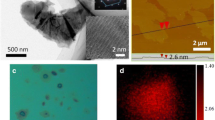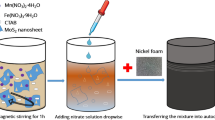Abstract
Two-dimensional (2D) molybdenum disulfide (MoS2) nanomaterials have emerged as promising candidates for constructing excellent supercapacitors, but the lack of large-scale, efficient and low-cost methods for preparing MoS2 nanosheets severely hinders its practical application. This study demonstrates an accessible and efficient approach for electrochemical exfoliating bulk MoS2 into high-quality MoS2 nanosheets with size distribution in the range of 1–3 μm and a thickness of several nanometers in an easily available inorganic salt solution. Furthermore, we construct symmetric all-solid-state supercapacitors based on exfoliated MoS2 nanosheets. The 2D structure will provide stable channels to facilitate the intercalation/desorption of ions during charge and discharge, and to a certain extent can prevent deposition and agglomeration. Therefore, compared with the unexfoliated MoS2, as-prepared MoS2 nanosheets show great improvement in supercapacitor performance (the specific capacitance increases from the original 130 F g−1 to 215 F g−1 at 5 A g−1, for instance). In detail, the electrode possesses a specific capacitance of 285 F g−1 at a current density of 2 A g−1 and maintains the great capacitance retention of 83.8% at 8 A g−1. Moreover, the supercapacitor exhibits a high energy density of 136.8 Wh kg−1 at a power density of 2550 Wh kg−1. This work provides basic research on the preparation of 2D nanomaterials by electrochemical exfoliation.






Similar content being viewed by others
Data availability
The data used to support the results of this study are from the corresponding authors. All data are obtained through reasonable experimental methods and all experimental data are true and valid.
References
H. Huang, M. Yan, C. Yang, H. He, Q. Jiang, L. Yang, Z. Lu, Z. Sun, X. Xu, Y. Bando, Graphenenanoarchitectonics: recent advances in graphene-based electrocatalysts for hydrogen evolution reaction. Adv. Mater. 31(48), 1903415 (2019)
D. Nandi, V.B. Mohan, A.K. Bhowmick, D. Bhattacharyya, Metal/metal oxide decorated graphene synthesis and application as supercapacitor: a review. J. Mater. Sci. 21, 1–26 (2020)
K.S. Novoselov, A.K. Geim, S.V. Morozov, D. Jiang, Y. Zhang, S.V. Dubonos, I.V. Grigorieva, A.A. Firsov, Electric field effect in atomically thin carbon films. Science 306(5696), 666–669 (2004)
L. Li, Z. Qin, L. Ries, S. Hong, T. Michel, J. Yang, C. Salameh, M. Bechelany, P. Miele, D. Kaplan, Role of sulfur vacancies and undercoordinated Mo regions in MoS2nanosheets toward the evolution of hydrogen. ACS Nano 13(6), 6824–6834 (2019)
T. Su, Z.D. Hood, M. Naguib, L. Bai, S. Luo, C.M. Rouleau, I.N. Ivanov, H. Ji, Z. Qin, Z. Wu, 2D/2D heterojunction of Ti3C2/gC3N4nanosheets for enhanced photocatalytic hydrogen evolution. Nanoscale. 11(17), 8138–8149 (2019)
M. Chhowalla, H.S. Shin, G. Eda, L.-J. Li, K.P. Loh, H. Zhang, The chemistry of two-dimensional layered transition metal dichalcogenidenanosheets. Nat. Chem. 5(4), 263 (2013)
R. Lv, J.A. Robinson, R.E. Schaak, D. Sun, Y. Sun, T.E. Mallouk, M. Terrones, Transition metal dichalcogenides and beyond: synthesis, properties, and applications of single-and few-layer nanosheets. Accounts Chem. Res. 48(1), 56–64 (2014)
W. Peng, W. Wang, G. Han, Y. Huang, Y. Zhang, Fabrication of 3D flower-like MoS2/graphene composite as high-performance electrode for capacitive deionization. Desalination 473(114191), 289 (2020)
X. Wang, J. Hu, W. Liu, G. Wang, J. An, J. Lian, Ni–Zn binary system hydroxide, oxide and sulfide materials: synthesis and high supercapacitor performance. J. Mater. Chem. A 3(46), 23333–23344 (2015)
G. Yu, L. Hu, N. Liu, H. Wang, M. Vosgueritchian, Y. Yang, Y. Cui, Z. Bao, Enhancing the supercapacitor performance of graphene/MnO2 nanostructured electrodes by conductive wrapping. NanoLett. 11(10), 4438–4442 (2011)
H. Liu, B. Chen, L. Liao, P. Fan, Y. Hai, Y. Wu, G. Lv, L. Mei, H. Hao, J. Xing, The influences of Mg intercalation on the structure and supercapacitivebehaviors of MoS2. J. Mater. Sci. 54(20), 13247–13254 (2019)
X. Yu, S. Yun, J.S. Yeon, P. Bhattacharya, L. Wang, S.W. Lee, X. Hu, H.S. Park, Emergent pseudocapacitance of 2D nanomaterials. Adv. Energy Mater. 8(13), 1702930 (2018)
L. Lin, W. Lei, S. Zhang, Y. Liu, G.G. Wallace, J. Chen, Two-dimensional transition metal dichalcogenides in supercapacitors and secondary batteries. Energy Storage Mater. 19, 408–423 (2019)
T. Stephenson, Z. Li, B. Olsen, D. Mitlin, Lithium ion battery applications of molybdenum disulfide (MoS2) nanocomposites. Energy Environ. Sci. 7(1), 209–231 (2014)
J. Yu, X. Hu, H. Li, X. Zhou, T. Zhai, Large-scale synthesis of 2D metal dichalcogenides. J. Mater. Chem. C. 6(17), 4627–4640 (2018)
Y. Shi, H. Li, L.-J. Li, Recent advances in controlled synthesis of two-dimensional transition metal dichalcogenides via vapour deposition techniques. Chem. Soc. Rev. 44(9), 2744–2756 (2015)
O. Lopez-Sanchez, D. Lembke, M. Kayci, A. Radenovic, A. Kis, Ultrasensitive photodetectors based on monolayer MoS2. Nat. Nanotechnol. 8(7), 497–501 (2013)
L. Niu, J.N. Coleman, H. Zhang, H. Shin, M. Chhowalla, Z. Zheng, Production of two-dimensional nanomaterials via liquid-based direct exfoliation. Small. 12(3), 272–293 (2016)
J. Wang, K.K. Manga, Q. Bao, K.P. Loh, High-yield synthesis of few-layer graphene flakes through electrochemical expansion of graphite in propylene carbonate electrolyte. J. Am. Chem. Soc. 133(23), 8888–8891 (2011)
S. Yang, P. Zhang, F. Wang, A.G. Ricciardulli, M.R. Lohe, P.W. Blom, X. Feng, Fluoride-free synthesis of two-dimensional titanium carbide (MXene) using a binary aqueous system. Angew. Chem. 130(47), 15717–15721 (2018)
I. Khakpour, A. RabieiBaboukani, A. Allagui, C. Wang, Bipolar exfoliation and in situ deposition of high-quality graphene for supercapacitor application. ACS Appl. Energy Mater. 2(7), 4813–4820 (2019)
A. Ambrosi, M. Pumera, Exfoliation of layered materials using electrochemistry. Chem. Soc. Rev. 47(19), 7213–7224 (2018)
Z. Lin, Y. Liu, U. Halim, M. Ding, Y. Liu, Y. Wang, C. Jia, P. Chen, X. Duan, C. Wang, Solution-processable 2D semiconductors for high-performance large-area electronics. Nature 562(7726), 254–258 (2018)
A. Ejigu, I.A. Kinloch, E. Prestat, R.A. Dryfe, A simple electrochemical route to metallic phase trilayer MoS2: evaluation as electrocatalysts and supercapacitors. J. Mater. Chem. A 5(22), 11316–11330 (2017)
B. Wang, R. Hu, J. Zhang, Z. Huang, H. Qiao, L. Gong, X. Qi, 2D/2D SnS2/MoS2 layered heterojunction for enhanced supercapacitor performance. J. Am. Ceram. Soc. 60, 72–81 (2019)
P. Yu, S.E. Lowe, G.P. Simon, Y.L. Zhong, Electrochemical exfoliation of graphite and production of functional graphene. Curr. Opin. Colloid Interface Sci. 20(5–6), 329–338 (2015)
N. Liu, P. Kim, J.H. Kim, J.H. Ye, S. Kim, C.J. Lee, Large-area atomically thin MoS2nanosheets prepared using electrochemical exfoliation. ACS Nano 8(7), 6902–6910 (2014)
F. Li, M. Xue, X. Zhang, L. Chen, G.P. Knowles, D.R. MacFarlane, J. Zhang, Advanced composite 2D energy materials by simultaneous anodic and cathodic exfoliation. Adv. Energy Mater. 8(12), 1702794 (2018)
H. Li, Q. Zhang, C.C.R. Yap, B.K. Tay, T.H.T. Edwin, A. Olivier, D. Baillargeat, From bulk to monolayer MoS2: evolution of Raman scattering. Adv. Funct. Mater. 22(7), 1385–1390 (2012)
B. Chakraborty, H.R. Matte, A. Sood, C. Rao, Layer-dependent resonant Raman scattering of a few layer MoS2. J. Raman Spectrosc. 44(1), 92–96 (2013)
X. Chen, G. Xu, X. Ren, Z. Li, X. Qi, K. Huang, H. Zhang, Z. Huang, J. Zhong, A black/red phosphorus hybrid as an electrode material for high-performance Li-ion batteries and supercapacitors. J. Mater. Chem. A 5(14), 6581–6588 (2017)
X. Yang, L. Zhao, J. Lian, Arrays of hierarchical nickel sulfides/MoS2nanosheets supported on carbon nanotubes backbone as advanced anode materials for asymmetric supercapacitor. J. Power Sources 343, 373–382 (2017)
X. Liu, X. Qi, Z. Zhang, L. Ren, G. Hao, Y. Liu, Y. Wang, K. Huang, X. Wei, J. Li, Electrochemically reduced graphene oxide with porous structure as a binder-free electrode for high-rate supercapacitors. RSC Adv. 4(26), 13673–13679 (2014)
D. Vikraman, K. Karuppasamy, S. Hussain, A. Kathalingam, A. Sanmugam, J. Jung, H.-S. Kim, One-pot facile methodology to synthesize MoS2-graphene hybrid nanocomposites for supercapacitors with improved electrochemical capacitance. Compos. Part B 161, 555–563 (2019)
X. Wang, J. Ding, S. Yao, X. Wu, Q. Feng, Z. Wang, B. Geng, High supercapacitor and adsorption behaviors of flower-like MoS 2 nanostructures. J. Mater. Chem. A 2(38), 15958–15963 (2014)
Y. Wang, Y. Song, Y. Xia, Electrochemical capacitors: mechanism, materials, systems, characterization and applications. Chem. Soc. Rev. 45(21), 5925–5950 (2016)
K.J. Samdani, S.H. Kim, J.H. Park, S.H. Hong, K.T. Lee, Morphology-controlled synthesis of Co3O4 composites with bio-inspired carbons as high-performance supercapacitor electrode materials. J. Ind. Engin Chem. 74, 96–102 (2019)
M. Liu, Z. Wang, J. Liu, G. Wei, J. Du, Y. Li, C. An, J. Zhang, Synthesis of few-layer 1T′-MoTe 2 ultrathin nanosheets for high-performance pseudocapacitors. J. Mater. Chem. A 5(3), 1035–1042 (2017)
K.-J. Huang, L. Wang, Y.-J. Liu, Y.-M. Liu, H.-B. Wang, T. Gan, L.-L. Wang, Layered MoS2–graphene composites for supercapacitor applications with enhanced capacitive performance. Int. J. Hydrogen Energy. 38(32), 14027–14034 (2013)
M.-C. Liu, Y. Xu, Y.-X. Hu, Q.-Q. Yang, L.-B. Kong, W.-W. Liu, W.-J. Niu, Y.-L. Chueh, Electrostatically charged MoS2/graphene oxide hybrid composites for excellent electrochemical energy storage devices. ACS Appl. Mater. Interfaces 10(41), 35571–35579 (2018)
Acknowledgements
This work was supported by the Grants from Provincial Natural Science Foundation of Hunan (No. 2019JJ50612), Hunan Key Laboratory of Two-Dimensional Materials (No. 2018TP1010), Open Fund based on innovation platform of Hunan colleges and universities (No. 18K032), National Natural Science Foundation of China (No. 11504312), Scientific Research Fund of Hunan Provincial Education Department (No. 18A059), the Program for Changjiang Scholars and Innovative Research Team in University (No. IRT_17R91) and Science and Technology Program of Xiangtan (No. CXY-ZD20172002).
Author information
Authors and Affiliations
Contributions
RH led the experiment, processed the data and wrote the paper; ZH analyzed the data and modified its grammar; BW and HQ conducted the experiment and discussed the results; XQ proposed the research plan and analyzed the data.
Corresponding authors
Ethics declarations
Conflict of interest
The authors have declared that no competing interests exist, and the manuscript is original work and has not been published in any journal or magazine before. The manuscript has no conflicts of interest and all authors agree to the publication of the paper.
Ethical approval
The authors declare that they have no conflict of interest, and the manuscript is original work and has not been published in any journal or magazine before. All procedures performed in studies involving human participants were in accordance with the ethical standards of the institutional and/or national research committee and with the 1964 Helsinki declaration and its later amendments or comparable ethical standards. This article does not contain any studies with animals performed by any of the authors. Informed consent was obtained from all individual participants included in the study.
Additional information
Publisher's Note
Springer Nature remains neutral with regard to jurisdictional claims in published maps and institutional affiliations.
Supplementary Information
Below is the link to the electronic supplementary material.
Rights and permissions
About this article
Cite this article
Hu, R., Huang, Z., Wang, B. et al. Electrochemical exfoliation of molybdenum disulfide nanosheets for high-performance supercapacitors. J Mater Sci: Mater Electron 32, 7237–7248 (2021). https://doi.org/10.1007/s10854-021-05432-5
Received:
Accepted:
Published:
Issue Date:
DOI: https://doi.org/10.1007/s10854-021-05432-5




